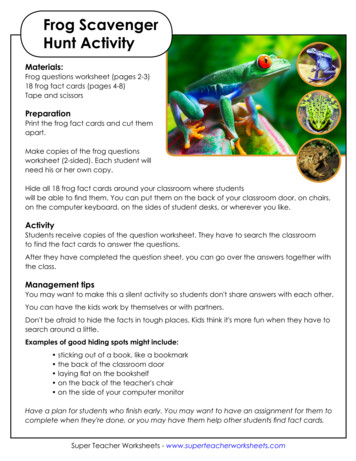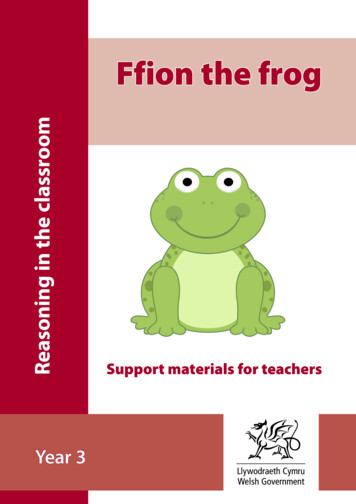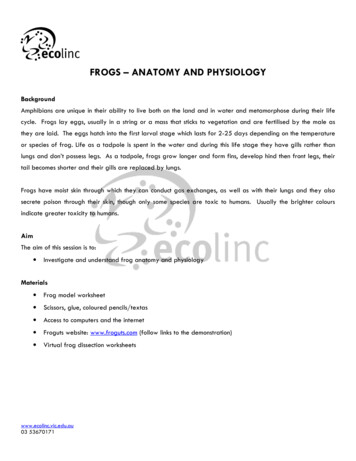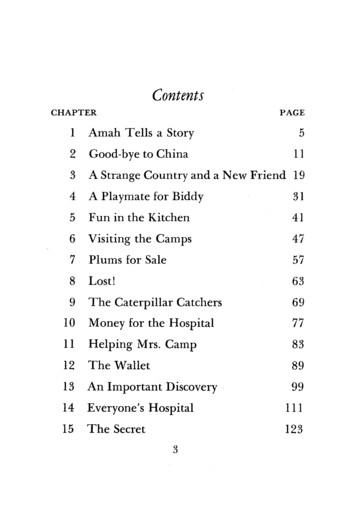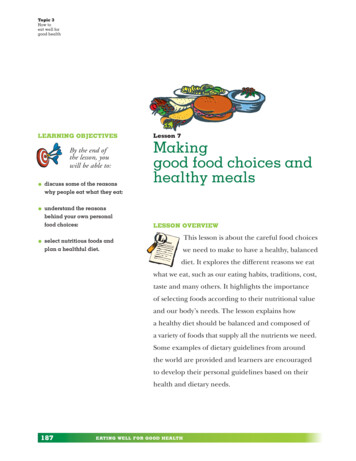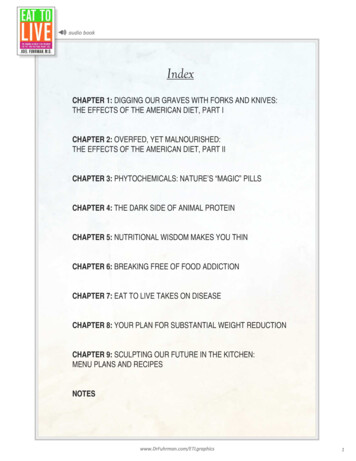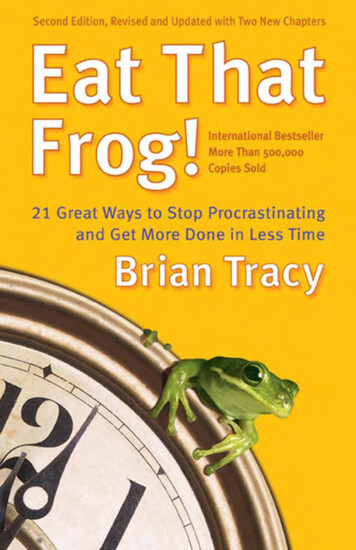
Transcription
Eat ThatFrog!
O t h e r B o o k s b y B r i a n Tr a c yMaximum AchievementAdvanced Selling StrategiesThe 100 Absolutely Unbreakable Laws of Business SuccessThe 21 Success Secrets of Self-Made MillionairesFocal PointVictory!Create Your Own FutureGoals!TurboStrategyBe a Sales SuperstarHire and Keep the Best PeopleGet Paid More and Promoted FasterChange Your Thinking, Change Your LifeMillion Dollar HabitsTime PowerGetting Rich Your Own WayTurboCoachThe Psychology of SellingSomething for NothingThe Art of Closing the SaleCrunch PointThe Way to Wealth
Eat ThatFrog!21 Great Ways toStop Procrastinatingand Get More Donein Less TimeBrian TracyBKBERRETT-KOEHLER PUBLISHERS, INC.San Franciscoa BK Life book
Eat That Frog!Copyright 2007 by Brian TracyAll rights reserved. No part of this publication may be reproduced, distributed, or transmitted in any form or by any means, including photocopying,recording, or other electronic or mechanical methods, without the prior written permission of the publisher, except in the case of brief quotationsembodied in critical reviews and certain other noncommercial uses permittedby copyright law. For permission requests, write to the publisher, addressed“Attention: Permissions Coordinator,” at the address below.BKBerrett-Koehler Publishers, Inc.235 Montgomery Street, Suite 650San Francisco, California 94104-2916Tel: (415) 288-0260, Fax: (415) 362-2512www.bkconnection.comOrdering information for print editionsQuantity sales. Special discounts are available on quantity purchases by corporations, associations, and others. For details, contact the “Special SalesDepartment” at the Berrett-Koehler address above.Individual sales. Berrett-Koehler publications are available through mostbookstores. They can also be ordered directly from Berrett-Koehler: Tel:(800) 929-2929; Fax: (802) 864-7626; www.bkconnection.comOrders for college textbook/course adoption use. Please contact BerrettKoehler: Tel: (800) 929-2929; Fax: (802) 864-7626.Orders by U.S. trade bookstores and wholesalers. Please contact IngramPublisher Services, Tel: (800) 509-4887; Fax: (800) 838-1149; m; or visit www.ingrampublisherservices.com/Ordering for details about electronic ordering.Berrett-Koehler and the BK logo are registered trademarks of Berrett-KoehlerPublishers, Inc.Cataloging-in-Publication Data are available from the Library of Congress.Second EditionPaperback print edition ISBN 978-1-57675-422-1PDF e-book ISBN 978-1-57675-504-42007-1Copyediting and proofreading by PeopleSpeak. Book design and compositionby Beverly Butterfield, Girl of the West Productions. Indexing by Rachel Rice.
To my remarkable daughter Catherine,an amazing girl with a wonderful mindand an incredible future lying before her
This page intentionally left blank
ContentsPrefaceIntroduction: Eat That Frog123456789101112131415161718192021ix1Set the TablePlan Every Day in AdvanceApply the 80/20 Rule to EverythingConsider the ConsequencesPractice Creative ProcrastinationUse the ABCDE Method ContinuallyFocus on Key Result AreasApply the Law of ThreePrepare Thoroughly Before You BeginTake It One Oil Barrel at a TimeUpgrade Your Key SkillsLeverage Your Special TalentsIdentify Your Key ConstraintsPut the Pressure on YourselfMaximize Your Personal PowersMotivate Yourself into ActionGet Out of the Technological Time SinksSlice and Dice the TaskCreate Large Chunks of TimeDevelop a Sense of UrgencySingle Handle Every nclusion: Putting It All TogetherIndexLearning Resources of Brian Tracy InternationalAbout the Author113119123127vii
This page intentionally left blank
PrefaceThank you for picking up this book. I hope theseideas help you as much as they have helped me and thousands of others. In fact, I hope that this book changesyour life forever.There is never enough time to do everything youhave to do. You are literally swamped with work and personal responsibilities, projects, stacks of magazines toread, and piles of books you intend to get to one of thesedays—as soon as you get caught up.But the fact is that you are never going to get caughtup. You will never get on top of your tasks. You willnever get far enough ahead to be able to get to all thosebooks, magazines, and leisure time activities that youdream of.And forget about solving your time managementproblems by becoming more productive. No matter howmany personal productivity techniques you master,there will always be more to do than you can ever accomplish in the time you have available to you, no matter how much it is.You can get control of your time and your life onlyby changing the way you think, work, and deal with thenever-ending river of responsibilities that flows over youeach day. You can get control of your tasks and activitiesonly to the degree that you stop doing some things andstart spending more time on the few activities that canreally make a difference in your life.ix
xeat that frog !I have studied time management for more than thirtyyears. I have immersed myself in the works of PeterDrucker, Alec Mackenzie, Alan Lakein, Stephen Covey,and many, many others. I have read hundreds of booksand thousands of articles on personal efficiency and effectiveness. This book is the result.Each time I came across a good idea, I tried it out in myown work and personal life. If it worked, I incorporated itinto my talks and seminars and taught it to others.Galileo once wrote, “You cannot teach a man anything; you can only help him find it within himself.”Depending upon your level of knowledge and experience, these ideas may sound familiar. This book willbring them to a higher level of awareness. When youlearn and apply these methods and techniques over andover until they become habits, you will alter the courseof your life in a very positive way.The Power of Written GoalsLet me tell you something about myself and the originsof this little book. I started off in life with few advantages, aside from a curious mind. I did poorly in schooland left without graduating. I worked at laboring jobs forseveral years. My future did not appear promising.As a young man, I got a job on a tramp freighter andwent off to see the world. For eight years, I traveled andworked and then traveled some more, eventually visitingmore than eighty countries on five continents.
PrefacexiWhen I could no longer find a laboring job, I got intosales, knocking on doors, working on straight commission. I struggled from sale to sale until I began lookingaround me and asking, “Why is it that other people aredoing better than I am?”Then I did something that changed my life. I beganto ask successful people what they were doing that enabled them to be more productive and earn more moneythan me. And they told me. I did what they advised meto do, and my sales went up. Eventually, I became so successful that I was made a sales manager. As a sales manager, I used the same strategy. I asked successful managerswhat they did to achieve such great results, and whenthey told me, I did it myself. In no time at all, I began toget the same results they did.This process of learning and applying what I hadlearned changed my life. I am still amazed at how simple and obvious it is. Just find out what other successfulpeople do and do the same things until you get the sameresults. Learn from the experts. Wow! What an idea.Success Is PredictableSimply put, some people are doing better than others because they do things differently and they do the rightthings right. Especially, successful, happy, prosperous people use their time far, far better than the average person.Coming from an unsuccessful background, I had developed deep feelings of inferiority and inadequacy. I
xiieat that frog !had fallen into the mental trap of assuming that peoplewho were doing better than me were actually betterthan me. What I learned was that this was not necessarily true. They were just doing things differently, andwhat they had learned to do, within reason, I couldlearn as well.This was a revelation to me. I was both amazed andexcited with this discovery. I still am. I realized that Icould change my life and achieve almost any goal I couldset if I just found out what others were doing in that areaand then did it myself until I got the same results theywere getting.Within one year of starting in sales, I was a top salesman. A year later I was made a manager. Within threeyears, I became a vice president in charge of a ninetyfive-person sales force in six countries. I was twenty-fiveyears old.Over the years, I have worked in twenty-two differentjobs; started and built several companies; earned a business degree from a major university; learned to speakFrench, German, and Spanish; and been a speaker, trainer,or consultant for more than 1,000 companies. I currentlygive talks and seminars to more than 250,000 people eachyear, with audiences as large as 20,000 people.A Simple TruthThroughout my career, I have discovered and rediscovered a simple truth. The ability to concentrate single-
Prefacexiiimindedly on your most important task, to do it well andto finish it completely, is the key to great success, achievement, respect, status, and happiness in life. This key insight is the heart and soul of this book.This book is written to show you how to get aheadmore rapidly in your career and to simultaneously enrich your personal life. These pages contain the twentyone most powerful principles on personal effectiveness Ihave ever discovered.These methods, techniques, and strategies are practical, proven, and fast acting. In the interest of time, I donot dwell on the various psychological or emotionalexplanations for procrastination or poor time management. There are no lengthy departures into theory or research. What you will learn are specific actions you cantake immediately to get better, faster results in your workand to increase your happiness.Every idea in this book is focused on increasing youroverall levels of productivity, performance, and outputand on making you more valuable in whatever you do.You can apply many of these ideas to your personal lifeas well.Each of these twenty-one methods and techniques iscomplete in itself. All are necessary. One strategy mightbe effective in one situation and another might apply toanother task. All together, these twenty-one ideas represent a smorgasbord of personal effectiveness techniquesthat you can use at any time, in any order or sequence thatmakes sense to you at the moment.
xiveat that frog !The key to success is action. These principles workto bring about fast, predictable improvements in performance and results. The faster you learn and applythem, the faster you will move ahead in your career—guaranteed!There will be no limit to what you can accomplishwhen you learn how to Eat That Frog!Brian TracySolana Beach, CaliforniaOctober 2006
Introduction: Eat That FrogThis is a wonderful time to be alive. There have neverbeen more possibilities and opportunities for you toachieve more of your goals than exist today. As perhapsnever before in human history, you are actually drowningin options. In fact, there are so many good things that youcan do that your ability to decide among them may be thecritical determinant of what you accomplish in life.If you are like most people today, you are overwhelmed with too much to do and too little time. As youstruggle to get caught up, new tasks and responsibilitiesjust keep rolling in, like the waves of the ocean. Becauseof this, you will never be able to do everything you haveto do. You will never be caught up. You will always be behind in some of your tasks and responsibilities, andprobably in many of them.The Need to Be SelectiveFor this reason, and perhaps more than ever before, yourability to select your most important task at each moment, and then to get started on that task and to get itdone both quickly and well, will probably have more ofan impact on your success than any other quality or skillyou can develop.An average person who develops the habit of settingclear priorities and getting important tasks completed1
2eat that frog !quickly will run circles around a genius who talks a lotand makes wonderful plans but who gets very little done.The Truth about FrogsMark Twain once said that if the first thing you do eachmorning is to eat a live frog, you can go through the daywith the satisfaction of knowing that that is probably theworst thing that is going to happen to you all day long.Your “frog” is your biggest, most important task, theone you are most likely to procrastinate on if you don'tdo something about it. It is also the one task that canhave the greatest positive impact on your life and resultsat the moment.The first rule of frog eating is this:If you have to eat two frogs, eat the ugliest one first.This is another way of saying that if you have twoimportant tasks before you, start with the biggest, hardest, and most important task first. Discipline yourself tobegin immediately and then to persist until the task iscomplete before you go on to something else.Think of this as a test. Treat it like a personal challenge. Resist the temptation to start with the easiertask. Continually remind yourself that one of the mostimportant decisions you make each day is what youwill do immediately and what you will do later, if youdo it at all.
Introduction: Eat That Frog3The second rule of frog eating is this:If you have to eat a live frog at all, it doesn't payto sit and look at it for very long.The key to reaching high levels of performance andproductivity is to develop the lifelong habit of tacklingyour major task first thing each morning. You must develop the routine of “eating your frog” before you doanything else and without taking too much time tothink about it.Take Action ImmediatelyIn study after study of men and women who get paidmore and promoted faster, the quality of “action orientation” stands out as the most observable and consistentbehavior they demonstrate in everything they do. Successful, effective people are those who launch directlyinto their major tasks and then discipline themselves towork steadily and single-mindedly until those tasks arecomplete.In our world, and especially in our business world,you are paid and promoted for getting specific, measurable results. You are paid for making a valuable contribution and especially for making the most importantcontribution that is expected of you.“Failure to execute” is one of the biggest problems inorganizations today. Many people confuse activity withaccomplishment. They talk continually, hold endless
4eat that frog !meetings, and make wonderful plans, but in the finalanalysis, no one does the job and gets the results required.Develop the Habits of SuccessYour success in life and work will be determined by thekinds of habits that you develop over time. The habit ofsetting priorities, overcoming procrastination, and getting on with your most important task is a mental andphysical skill. As such, this habit is learnable throughpractice and repetition, over and over again, until itlocks into your subconscious mind and becomes a permanent part of your behavior. Once it becomes a habit,it becomes both automatic and easy to do.This habit of starting and completing importanttasks has an immediate and continuous payoff. You aredesigned mentally and emotionally in such a way thattask completion gives you a positive feeling. It makesyou happy. It makes you feel like a winner.Whenever you complete a task of any size or importance, you feel a surge of energy, enthusiasm, and selfesteem. The more important the completed task, thehappier, more confident, and more powerful you feelabout yourself and your world.The completion of an important task triggers the release of endorphins in your brain. These endorphins giveyou a natural “high.” The endorphin rush that followssuccessful completion of any task makes you feel morepositive, personable, creative, and confident.
Introduction: Eat That Frog5Develop a Positive AddictionHere is one of the most important of the so-called secrets of success. You can actually develop a “positive addiction” to endorphins and to the feeling of enhancedclarity, confidence, and competence that they trigger.When you develop this addiction, you will, at an unconscious level, begin to organize your life in such away that you are continually starting and completingever more important tasks and projects. You will actually become addicted, in a very positive sense, to successand contribution.One of the keys to your living a wonderful life, having a successful career, and feeling terrific about yourselfis to develop the habit of starting and finishing important jobs. When you do, this behavior will take on apower of its own and you'll find it easier to complete important tasks than not to complete them.No ShortcutsYou remember the story of the man who stops a musician on a street in New York and asks how he can get toCarnegie Hall. The musician replies, “Practice, man,practice.”Practice is the key to mastering any skill. Fortunately,your mind is like a muscle. It grows stronger and morecapable with use. With practice, you can learn any behavior or develop any habit that you consider either desirable or necessary.
6eat that frog !The Three Ds of New Habit FormationYou need three key qualities to develop the habits offocus and concentration, which are all learnable. Theyare decision, discipline, and determination.First, make a decision to develop the habit of taskcompletion. Second, discipline yourself to practice theprinciples you are about to learn over and over untilthey become automatic. And third, back everything youdo with determination until the habit is locked in and becomes a permanent part of your personality.Visualize Yourself as You Want to BeThere is a special way that you can accelerate your progress toward becoming the highly productive, effective,efficient person that you want to be. It consists of yourthinking continually about the rewards and benefits ofbeing an action-oriented, fast-moving, and focused person. See yourself as the kind of person who gets important jobs done quickly and well on a consistent basis.Your mental picture of yourself has a powerful effecton your behavior. Visualize yourself as the person youintend to be in the future. Your self-image, the way yousee yourself on the inside, largely determines your performance on the outside. All improvements in your outerlife begin with improvements on the inside, in your mental pictures.You have a virtually unlimited ability to learn anddevelop new skills, habits, and abilities. When you train
Introduction: Eat That Frog7yourself, through repetition and practice, to overcomeprocrastination and get your most important tasks completed quickly, you will move yourself onto the fast trackin your life and career and step on the accelerator.Eat That Frog!
This page intentionally left blank
1Set the TableThere is one quality that one must possessto win, and that is definiteness of purpose,the knowledge of what one wants and aburning desire to achieve it.napoleon hillBefore you can determine your “frog” and get on withthe job of eating it, you have to decide exactly what youwant to achieve in each area of your life. Clarity is perhaps the most important concept in personal productivity. The number one reason why some people get morework done faster is because they are absolutely clearabout their goals and objectives, and they don’t deviatefrom them. The greater clarity you have regarding whatyou want and the steps you will have to take to achieveit, the easier it will be for you to overcome procrastination, eat your frog, and complete the task before you.A major reason for procrastination and lack of motivation is vagueness, confusion, and fuzzy-mindednessabout what you are trying to do and in what order andfor what reason. You must avoid this common conditionwith all your strength by striving for ever greater clarityin your major goals and tasks.9
10eat that frog !Here is a great rule for success:Think on paper.Only about 3 percent of adults have clear, writtengoals. These people accomplish five and ten times as muchas people of equal or better education and ability butwho, for whatever reason, have never taken the time towrite out exactly what they want.There is a powerful formula for setting and achievinggoals that you can use for the rest of your life. It consistsof seven simple steps. Any one of these steps can doubleand triple your productivity if you are not currentlyusing it. Many of my graduates have increased their incomes dramatically in a matter of a few years, or even afew months, with this simple, seven-part method.Step one: Decide exactly what you want. Either decidefor yourself or sit down with your boss and discuss yourgoals and objectives until you are crystal clear aboutwhat is expected of you and in what order of priority. Itis amazing how many people are working away, day afterday, on low-value tasks because they have not had thiscritical discussion with their managers.One of the very worst uses of time is to dosomething very well that need not be done at all.Stephen Covey says, “Before you begin scrambling up theladder of success, make sure that it is leaning against theright building.”
Set the Table11Step two: Write it down. Think on paper. When youwrite down a goal, you crystallize it and give it tangibleform. You create something that you can touch and see.On the other hand, a goal or objective that is not in writing is merely a wish or a fantasy. It has no energy behindit. Unwritten goals lead to confusion, vagueness, misdirection, and numerous mistakes.Step three: Set a deadline on your goal; set subdeadlinesif necessary. A goal or decision without a deadline has nourgency. It has no real beginning or end. Without a definite deadline accompanied by the assignment or acceptance of specific responsibilities for completion, you willnaturally procrastinate and get very little done.Step four: Make a list of everything that you can think ofthat you are going to have to do to achieve your goal. As youthink of new activities, add them to your list. Keep building your list until it is complete. A list gives you a visualpicture of the larger task or objective. It gives you a trackto run on. It dramatically increases the likelihood thatyou will achieve your goal as you have defined it and onschedule.Step five: Organize the list into a plan. Organize yourlist by priority and sequence. Take a few minutes to decide what you need to do first and what you can do later.Decide what has to be done before something else andwhat needs to be done afterward. Even better, lay outyour plan visually in the form of a series of boxes andcircles on a sheet of paper, with lines and arrows showing the relationship of each task to each other task.
12eat that frog !You’ll be amazed at how much easier it is to achieve yourgoal when you break it down into individual tasks.With a written goal and an organized plan of action,you will be far more productive and efficient than people who are carrying their goals around in their minds.Step six: Take action on your plan immediately. Dosomething. Do anything. An average plan vigorously executed is far better than a brilliant plan on which nothing is done. For you to achieve any kind of success,execution is everything.Step seven: Resolve to do something every single day thatmoves you toward your major goal. Build this activity intoyour daily schedule. You may decide to read a specificnumber of pages on a key subject. You may call on a specific number of prospects or customers. You may engagein a specific period of physical exercise. You may learna certain number of new words in a foreign language.Whatever it is, you must never miss a day.Keep pushing forward. Once you start moving, keepmoving. Don’t stop. This decision, this discipline alone,can dramatically increase your speed of goal accomplishment and boost your personal productivity.The Power of Written GoalsClear written goals have a wonderful effect on yourthinking. They motivate you and galvanize you into action. They stimulate your creativity, release your energy,and help you to overcome procrastination as much asany other factor.
Set the Table13Goals are the fuel in the furnace of achievement. Thebigger your goals and the clearer they are, the more excited you become about achieving them. The more youthink about your goals, the greater become your innerdrive and desire to accomplish them.Think about your goals and review them daily. Everymorning when you begin, take action on the most important task you can accomplish to achieve your mostimportant goal at the moment.eat that frog !1.Take a clean sheet of paper right now and make a listof ten goals you want to accomplish in the next year.Write your goals as though a year has already passed andthey are now a reality.Use the present tense, positive voice, and first personso that they are immediately accepted by your subconscious mind. For example, you could write. “I earn x number of dollars per year” or “I weigh x number of pounds”or “I drive such and such a car.”2.Review your list of ten goals and select the one goalthat, if you achieved it, would have the greatest positiveimpact on your life. Whatever that goal is, write it on aseparate sheet of paper, set a deadline, make a plan, takeaction on your plan, and then do something every singleday that moves you toward that goal. This exercise alonecould change your life!
2Plan Every Dayin AdvancePlanning is bringing the future into the presentso that you can do something about it now.alan lakeinYou have heard the old question, “How do you eat anelephant?” The answer is “One bite at a time!”How do you eat your biggest, ugliest frog? The sameway; you break it down into specific step-by-step activities and then you start on the first one.Your mind, your ability to think, plan, and decide, isyour most powerful tool for overcoming procrastinationand increasing your productivity. Your ability to set goals,make plans, and take action on them determines thecourse of your life. The very act of thinking and planning unlocks your mental powers, triggers your creativity, and increases your mental and physical energies.Conversely, as Alec Mackenzie wrote, “Taking actionwithout thinking things through is a prime source of problems.”Your ability to make good plans before you act is ameasure of your overall competence. The better the14
Plan Every Day in Advance15plan you have, the easier it is for you to overcome procrastination, to get started, to eat your frog, and then tokeep going.Increase Your Return on EnergyOne of your top goals at work should be for you to getthe highest possible return on your investment of mental, emotional, and physical energy. The good news isthat every minute spent in planning saves as many asten minutes in execution. It takes only about 10 to 12minutes for you to plan out your day, but this small investment of time will save you up to two hours (100 to120 minutes) in wasted time and diffused effort throughout the day.You may have heard of the Six-P Formula. It says,“Proper Prior Planning Prevents Poor Performance.”When you consider how helpful planning can be inincreasing your productivity and performance, it is amazing how few people practice it every single day. And planning is really quite simple to do. All you need is a pieceof paper and a pen. The most sophisticated Palm Pilot,computer program, or time planner is based on the sameprinciple. It is based on your sitting down and making alist of everything you have to do before you begin.Two Extra Hours per DayAlways work from a list. When something new comes up,add it to the list before you do it. You can increase yourproductivity and output by 25 percent or more—about
16eat that frog !two hours a day—from the first day that you begin working consistently from a list.Make your list the night before for the workday ahead.Move everything that you have not yet accomplishedonto your list for the coming day, and then add everything that you have to do the next day. When you makeyour list the night before, your subconscious mind willwork on your list all night long while you sleep. Oftenyou will wake up with great ideas and insights that youcan use to get your job done faster and better than you hadinitially thought.The more time you take to make written lists of everything you have to do, in advance, the more effectiveand efficient you will be.Different Lists for Different PurposesYou need different lists for different purposes. First, youshould create a master list on which you write downeverything you can think of that you want to do sometime in the future. This is the place where you captureevery idea and every new task or responsibility thatcomes up. You can sort out the items later.Second, you should have a monthly list that you makeat the end of the month for the month ahead. This maycontain items transferred from your master list.Third, you should have a weekly list where you planyour entire week in advance. This is a list that is underconstruction as you go through the current week.
Plan Every Day in Advance17This discipline of systematic time planning can bevery helpful to you. Many people have told me that thehabit of taking a couple of hours at the end of each weekto plan the coming week has increased their productivity dramatically and changed their lives completely. Thistechnique will work for you as well.Finally, you should transfer items from your monthlyand weekly lists onto your daily list. These are the specific activities that you are going to accomplish the following day.As you work through the day, tick off the items onyour list as you complete them. This activity gives you avisual picture of accom
Eat That Frog! 21 GreatWaysto Stop Procrastinating and GetMore Done in LessTime Brian Tracy BK BERRETT-KOEHLER PUBLI
